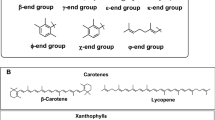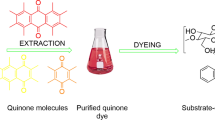Abstract
L-Ascorbic acid, α-tocopherol, procyanidin B3, β-carotene and astaxanthin are five classic dietary antioxidants. In this study, the interaction between the five antioxidants and ovalbumin was investigated by fluorescence spectroscopy, in combination with UV-vis absorption spectroscopy and circular dichroism (CD) spectroscopy. The quenching mechanism of ovalbumin by α-tocopherol is static quenching and the interaction between α-tocopherol and ovalbumin is synergistically driven by enthalpy and entropy. Electrostatic interactions and hydrophobic interactions play a major role in stabilizing the complex. For the other four antioxidants, the quenching mechanisms are all static quenching mechanisms at lower concentrations of antioxidants, but at higher concentrations of antioxidants, predominantly by the “sphere of action” quenching mechanisms. The binding processes of the other four antioxidants to ovalbumin are all entropy process and the major part of the action force is hydrophobic interactions. The binding constants of ovalbumin with the five antioxidants are in the following order as: astaxanthin > β-carotene > L-ascorbic acid > procyanidin B3 > α-tocopherol at 298 K. Synchronous fluorescence spectroscopy shows the interaction between L-ascorbic acid/β-carotene/astaxanthin and ovalbumin decreases the hydrophobicity of the microenvironment of tryptophan (Trp) and tyrosine (Tyr) residues. The hydrophobicity of Trp is increased while the hydrophility of Tyr is increased in the presence of α-tocopherol. However, the microenvironment of Trp and Tyr is not affected by procyanidin B3. The UV-vis absorption and CD spectra suggest that the interaction between the five antioxidants and ovalbumin leads to the loosening and unfolding of ovalbumin skeleton and exerts some influence on the natural secondary structure of ovalbumin. The study provides an accurate and full basic data for clarifying the binding mechanisms of L-ascorbic acid, α-tocopherol, procyanidin B3, β-carotene and astaxanthin interacting with ovalbumin and is helpful for understanding rational use of antioxidants as dietary supplements.







Similar content being viewed by others
References
Wu D, Yan J, Tang P et al (2015) Binding properties and structure–affinity relationships of food antioxidant butylated hydroxyanisole and its metabolites with lysozyme. Food Chem 188:370–376
Lu XQ, Nan MN, Zhang HR et al (2007) Investigation of the antioxidant property of ascorbic acid. J Phys Chem C 111:14998–15002
Krumova K, Friedland S, Cosa G (2012) How lipid unsaturation, peroxyl radical partitioning, and chromanol lipophilic tail affect the antioxidant activity of α-tocopherol: direct visualization via high-throughput fluorescence studies conducted with fluorogenic α-tocopherol analogues. J Am Chem Soc 134:10102–10113
Scalbert A, Williamson G (2000) Dietary intake and bioavailability of polyphenols. J Nutr 130:2073–2085
Gonçalves R, Mateus N, Freitas VD (2011) Influence of carbohydrates on the interaction of procyanidin B3 with trypsin. J Agric Food Chem 59:11794–11802
Britton G (1995) Structure and properties of carotenoids in relation to function. FASEB J 9:1551–1558
Knockaert G, Pulissery SK, Lemmens L et al (2012) Carrot β-carotene degradation and isomerization kinetics during thermal processing in the presence of oil. J Agric Food Chem 60:10312–10319
Hussein G, Sankawa U, Goto H et al (2006) Astaxanthin, a carotenoid with potential in human health and nutrition. J Nat Prod 69:443–449
Sponton OE, Perez AA, Carrara CR et al (2015) Linoleic acid binding properties of ovalbumin nanoparticles. Colloids Surf B 128:219–226
Weijers M, Sagis LMC, Veerman C et al (2002) Rheology and structure of ovalbumin gels at low pH and low ionic strength. Food Hydrocoll 16:269–276
Creamer LK, Jimenez-Flores R, Richardson T (1988) Genetic modification of food proteins. Trends Biotechnol 6:163–169
Venturoli D, Rippe B (2005) Ficoll and dextran vs. globular proteins as probes for testing glomerular permselectivity: effects of molecular size, shape, charge, and deformability. Am J Physiol Ren Physiol 288:F605–F613
Cannan RK, Kibrick A, Palmer AH (1941) The amphoteric properties of egg albumin. Ann N Y Acad Sci 41:243–266
Hu HY, Du HN (2000) Alpha to beta structural transformation of ovalbumin: heat and pH effects. J Protein Chem 19:177–183
Croguennec T, Renault A, Beaufils S et al (2007) Interfacial properties of heat-treated ovalbumin. J Colloid Interface Sci 315:627–636
Giosafatto CVL, Rigby NM, Wellner N et al (2012) Microbial transglutaminase-mediated modification of ovalbumin. Food Hydrocoll 26:261–267
Nisbet AD, Saundry RH, Moir AJG et al (1981) The complete amino-acid sequence of hen ovalbumin. Eur J Biochem 115:335–345
Stein PE, Leslie AG, Finch JT et al (1991) Crystal structure of uncleaved ovalbumin at 1.95 A resolution. J Mol Biol 221:941–959
Sponton OE, Perez AA, Carrara CR et al (2015) Impact of environment conditions on physicochemical characteristics of ovalbumin heat-induced nanoparticles and on their ability to bind PUFAs. Food Hydrocoll 48:165–173
Wright HT, Qian HX, Huber RJ (1990) Crystal structure of plakalbumin, a proteolytically nicked form of ovalbumin. Its relationship to the structure of cleaved alpha-1-proteinase inhibitor. J Mol Biol 213:513–528
Stein PE, Leslie AG, Finch JT et al (1990) Crystal structure of ovalbumin as a model for the reactive Centre of serpins. Nature 347:99–102
Wang RQ, Yin YJ, Li H et al (2013) Comparative study of the interactions between ovalbumin and three alkaloids by spectrofluorimetry. Mol Biol Rep 40:3409–3418
Kamilya T, Pal P, Talapatra GB (2007) Interaction and incorporation of ovalbumin with stearic acid monolayer: Langmuir–Blodgett film formation and deposition. Colloids Surf B 58:137–144
Ognjenović J, Stojadinović M, Milčić M et al (2014) Interactions of epigallo-catechin 3-gallate and ovalbumin, the major allergen of egg white. Food Chem 164:36–43
Niu F, Su Y, Liu Y et al (2014) Ovalbumin–gum arabic interactions: effect of pH, temperature, salt, biopolymers ratio and total concentration. Colloids Surf B 113:477–482
Shen F, Niu F, Li J et al (2014) Interactions between tea polyphenol and two kinds of typical egg white proteins-ovalbumin and lysozyme: effect on the gastrointestinal digestion of both proteins in vitro. Food Res Int 59:100–107
Lu Y, Wang YL, Gao SH et al (2009) Interaction of quercetin with ovalbumin: spectroscopic and molecular modeling studies. J Lumin 129:1048–1054
Mareeswaran PM, Maheshwaran D, Babu E et al (2012) Binding and fluorescence resonance energy transfer (FRET) of ruthenium(II)-bipyridine-calixarene system with proteins-experimental and docking studies. J Fluoresc 22:1345–1356
Mathavan A, Ramdass A, Rajagopal S (2015) A spectroscopy approach for the study of the interaction of oxovanadium(IV)-salen complexes with proteins. J Fluoresc 25:1141–1149
Sampson HA (2004) Update on food allergy. J Allergy Clin Immun 113:805–819
Sur SS, Rabbani LD, Libman L et al (1979) Fluorescence studies of native and modified neurophysins. Effects of peptides and pH. Biochemistry 18:1026–1036
Yuan T, Weljie AM, Vogel HJ (1998) Tryptophan fluorescence quenching by methionine and selenomethionine residues of calmodulin: orientation of peptide and protein binding. Biochemistry 37:3187–3195
Lakowicz JR (2006) Principles of fluorescence spectroscopy, third edn. Springer Science & Business Media, New York, p. 531
Lakowicz JR (2006) Principles of fluorescence spectroscopy, third edn. Springer Science & Business Media, New York, p. 278
Ware WR (1962) Oxygen quenching of fluorescence in solution: an experimental study of the diffusion process. J Phys Chem 66:455–458
Tan C, Atas E, Műller JG et al (2004) Amplified quenching of a conjugated polyelectrolyte by cyanine dyes. J Am Chem Soc 126:13685–13694
Lakowicz JR (2006) Principles of fluorescence spectroscopy, third edn. Springer Science & Business Media, New York, p. 281
Lakowicz JR (2006) Principles of fluorescence spectroscopy, third edn. Springer Science & Business Media, New York, p. 283
Soares S, Mateus N, Freitas VD (2007) Interaction of different polyphenols with bovine serum albumin (BSA) and human salivary a-amylase (HSA) by fluorescence quenching. J Agric Food Chem 55:6726–6735
Ross PD, Subramanian S (1981) Thermodynamics of protein association reactions: forces contributing to stability. Biochemistry 20:3096–3102
Vekshin NL (1996) Separation of the tyrosine and tryptophan components of fluorescence using synchronous scanning method. Biofizika 41:1176–1179
Brustein EA, Vedenkina NS, Ivkova MN (1973) Fluorescence and the location of tryptophan residues in protein molecules. Photochem Photobiol 18:263–279
Miller JN (1979) Recent advances in molecular luminescence analysis. Proc Anal Div Chem Soc 16:203–208
Mandal P, Ganguly T (2009) Fluorescence spectroscopic characterization of the interaction of human adult hemoglobin and two isatins, 1-methylisatin and 1-phenylisatin: a comparative study. J Phys Chem B 113:14904–14913
Glazer AN, Smith EL (1961) Studies on the ultraviolet different spectra of protein and polypeptides. J Biol Chem 236:2942–2947
Acknowledgments
This work was supported by the Key Research Project of Colleges and Universities of Henan Province (15 A150004), the Doctoral Startup Fund of Xinxiang Medical University (505078, 201509), the Foundation for Fostering of Xinxiang Medical University (2014QN122, 2014QN124) and the Fund of Fluorescence Probe and Biomedical Detection Research Team of Xinxiang City (CXTD16001).
Author information
Authors and Affiliations
Corresponding author
Ethics declarations
Conflict of Interest
The authors declare that there are no conflicts of interest.
Electronic supplementary material
ESM 1
(DOCX 634 kb)
Rights and permissions
About this article
Cite this article
Li, X., Yan, Y. Comparative Study of the Interactions between Ovalbumin and five Antioxidants by Spectroscopic Methods. J Fluoresc 27, 213–225 (2017). https://doi.org/10.1007/s10895-016-1948-3
Received:
Accepted:
Published:
Issue Date:
DOI: https://doi.org/10.1007/s10895-016-1948-3




